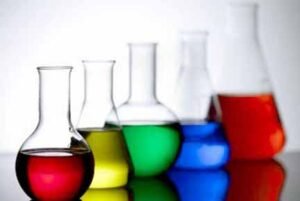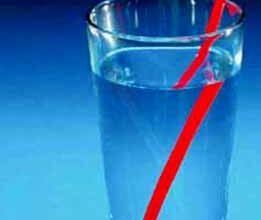
|
दो या दो से अधिक पदार्थों का एक एक समांग मिश्रण है, जिसे किसी निश्चित ताप पर विलेय (Solute) और विलायक (Solvent) की आपेक्षिक मात्राएँ एक निश्चित सीमा तक निरंतर परिवर्तित हो सकती है. उदाहरण :- नमक या चीनी का जल (water) में विलियन. विलयन (solution) की विशेषताएं … · विलयन दो या दो से अधिक पदार्थों का समांग मिश्रण है. · किसी विलयन में विलेय के कणों की त्रिज्या 10-7 सेमी से कम होती है. अत: इन कणों को सूक्ष्मदर्शी (microscopes) द्वारा भी नहीं देखा जा सकता है. · विलयन में विलेय के कण विलायक में इस प्रकार घुल-मिल जाते हैं कि एक का दूसरे से विभेद करना संभव नहीं होता है. · विलयन में उपस्थित विलेय के कण छन्ना पत्र के आर-पार आ-जा सकते हैं. · विलयन स्थायी एवं पारदर्शक होता है. विलेय (Solute) और विलायक (Solvent)… विलयन (solution) में जो पदार्थ अपेक्षाकृत अधिक मात्रा में होता है, उसे विलायक (solvent) कहते हैं, तथा जो पदार्थ कम मात्रा में उपस्थित रहता है, उसे विलेय (solute) कहते हैं. जिस विलायक का डाइइलेक्ट्रिक नियतांक (Dielectric Constant) जितना अधिक होता है, वह उतना ही अच्छा विलायक (Solvent) माना जाता है. जल का डाइइलेक्ट्रिक नियतांक का मान अधिक होने के कारण इसे सार्वत्रिक विलायक (Universal solvent) कहा जाता है. विलायकों (Solvents) के उपयोग… · औषधियों (Medicines) के निर्माण में, · निर्जल धुलाई ((Anhydrous washing) में- उदाहरण :- बेंजीन व पेट्रोल, · इत्र (Perfume) निर्माण में, · रंग, रोगन को घोलने में, · अनेक प्रकार के पेय व खाद्य पदार्थों के निर्माण में, विलयनों का वर्गीकरण (Classification of solutions)… विलयनों के प्रकार उदाहरण 1. गैस में गैस का विलयन वायु, गैसों का मिश्रण 2. गैस में द्रव का विलयन ब्रोमीन, कार्बन डाइऑक्साइड, अमोनिया आदि गैसों का जल में जल में विलयन, बादल, कुहरा आदि. 3. गैस में ठोस का विलयन वायु में आयोडीन का विलयन, धुआँ आदि. 4. द्रव में गैस का विलयन जल में कार्बन डाइऑक्साइड का विलयन, बेजीन में हाइड्रोजन क्लोराइड गैस का विलयन आदि. 5. द्रव में द्रव का विलयन : – ब्रोमीन का विलयन, सल्फ्यूरिक अम्ल का जल में विलयन आदि. 6. द्रव में ठोस का विलयन : – आयोडीन का विलयन, पारा में लेड का विलयन, जेली, स्टार्च, प्रोटीन, सॉल आदि. 7. ठोस में गैस का विलयन : – पैलेडियम धातु में हाइड्रोजन का विलयन, कपूर का वायु में विलयन आदि. 8. ठोस में द्रव का विलयन : – थैलियम में पारा का विलयन, चीनी में जल का विलयन, नमक में जल का विलयन आदि 9. ठोस में ठोस का विलयन : – ताँबा में जस्ता, ताँबा में टिन, ताँबा में ऐलुमिनियम, ताँबा में जिंक व निकेल आदि का विलयन. संतृप्त विलयन(Saturated solution) :- किसी निश्चित ताप पर बना एक ऐसा विलयन जिसमें विलेय पदार्थ की अधिकतम मात्रा घुली हुई हो, संतृप्त विलयन कहलाता है. असंतृप्त विलयन (Unsaturated Solution) :- किसी निश्चित ताप पर बना ऐसा विलयन जिसमें विलेय पदार्थ की और अधिक मात्रा उस ताप पर घुलाई जा सकती है, असंतृप्त विलयन कहलाता है. अति संतृप्त विलयन (Hypertrifetic Solution) :- ऐसा संतृप्त विलयन जिसमें विलेय की मात्रा उस विलयन को संतृप्त करने के लिए आवश्यक विलेय की मात्रा से अधिक घुली हुई हो, अतिसंतृप्त विलयन कहलाता है. विलेयता (Solubility) :- किसी निश्चित ताप और दाब पर 100 ग्राम विलायक में घुलने वाली विलेय की अधिकतम मात्रा को उस विलेय पदार्थ की उस विलायक में विलेयता कहते हैं. यदि t° C पर W ग्राम जल में किसी विलेय पदार्थ के अधिक से अधिक w ग्राम घुले हुए हों, तो उस ताप पर उस विलेय की जल में विलेयता =w×100W=w×100W. विलेयता पर ताप का प्रभाव (Effect of heating on solubility) :- · सामान्यतः ठोस पदार्थों की विलेयता ताप बढ़ाने से बढ़ती है. लेकिन कुछ ऐसे भी ठोस पदार्थ हैं, जिनकी विलेयता ताप बढ़ाने से घटती है. उदाहरण :- सोडियम सल्फेट, कैल्सियम हाइड्रॉक्साइड, कैल्सियम साइट्रेट आदि. · किसी द्रव में गैस की विलेयता ताप बढ़ने से घटती है. विलेयता संबंधी प्रमुख तथ्य (Key facts about solubility) :- o अधुवीय पदार्थ अधुवीय विलायकों में प्रायः विलेय होते हैं. उदाहरण :- ब्रोमीन का कार्बन टेट्राक्लोराइड में घुलना. o अधुवीय पदार्थ ध्रुवीय विलायकों में प्रायः अधिक विलेय नहीं होते हैं. उदाहरण :- कार्बन टेट्राक्लोराइड जल में बहुत ही कम विलेय होते हैं. o ध्रुवीय पदार्थ धुवीय विलायकों में प्रायः विलेय होते हैं. उदाहरण :- इथाइल ऐल्कोहॉल जल में काफी विलेय होता है. o ध्रुवीय पदार्थ अधुवीय विलायकों में अधिक विलेय नहीं होते हैं. उदाहरण :- सोडियम – क्लोराइड कार्बन टेट्राक्लोराइड में अल्प विलेय होता है. o अणुभार में वृद्धि होने से पदार्थों की विलेयता घटती जाती है. उदाहरण :- मिथाइल ऐल्कोहॉल (अणुभार-32) की तुलना में ब्यूटाइल ऐल्कोहॉल (अणुभार- 74) जल में बहुत कम विलेय होता है. विलयन का सांद्रण (Concentration of Solution) :- किसी विलायक या विलयन की इकाई मात्रा में उपस्थित विलेय की मात्रा को विलयन का सांद्रण कहते हैं. जिस विलयन में विलेय की पर्याप्त मात्रा घुली रहती है, उसे सांद्र विलयन (Concentrated solution) कहा जाता है तथा जिस विलयन में विलेय की कम मात्रा घुली रहती है, उसे तनु विलयन (Dilute Solution) कहा जाता है. सभी तनु विलयन असंतृप्त विलयन होते हैं, जो विलयन जितना ही अधिक तनु होता है वह उतना ही अधिक असंतृप्त होता है. परिक्षेपन (Dispersion) :- किसी पदार्थ के कण (अणु, परमाणु या आयन) दूसरे पदार्थ के कणों के इर्द-गिर्द फैला दिया जाता हैं, तो यह क्रिया परिक्षेपण कहलाती है. पहले पदार्थ को प्रक्षेपित पदार्थ(Dispersed substance) और दूसरे को परिक्षेपण माध्यम(Dispersion Medium) कहा जाता है. परिक्षेपण के परिणामस्वरूप दो प्रकार के पदार्थों का निर्माण होता है :- 1. विषमांग पदार्थ (Heterogeneous Substance) जैसे- निलम्बन, कोलॉइड. 2. समांग पदार्थ (Homogeneous substance) जैसे- वास्तविक विलयन. निलम्बन (Suspension) :- छोटे आकार के कणों के पदार्थ जो विलायक में अघुलनशील, परन्तु नग्न आँखों से दृश्य होते हैं, निलम्बन देते हैं. · दो या दो से अधिक पदार्थों का विषमांग मिश्रण होता है. · इसमें परिक्षेपित कणों का आकार 10-5 सेमी या इससे अधिक होता है. · इसके कण छन्ना पत्र के आर-पार नहीं आ-जा सकते हैं. · परिक्षेपित कणों को नग्न आँखों से देखा जा सकता है. · ये अस्थायी होते हैं तथा इनके कणों में परिक्षेपित माध्यम से अलग हो जाने की प्रवृत्ति पायी जाती है. उदाहरण :- नदी का गंदा जल, वायु में धुआँ आदि. कोलॉइड (Colloid) :- · यह दो पदार्थों का विषमांग मिश्रण होता है. · इसके कणों को नग्न आँखों से नहीं देखा जा सकता, बल्कि इन्हें अति सूक्ष्मदर्शी (Ultra Microscope) की सहायता से ही देखा जा सकता है. · इसके कण छन्ना पत्र के आर-पार आ-जा सकते हैं. · यह स्थायी होता है. स्थिर छोड़ देने पर इसके कणों में परिक्षेपण माध्यम से अलग हो जाने की बहुत कम प्रवृत्ति पायी जाती है. उदाहरण :- दूध, गोंद और स्याही आदि. वास्तविक विलयन (True Solution) :- · यह दो या दो से अधिक पदार्थों का समांग मिश्रण होता है. · इसमें कण आण्विक आकार वाले होते हैं, अर्थात् इनके कणों का आकार 10-8 सेमी होता है. · इसके कण परिक्षेपण माध्यम के साथ इस प्रकार घुल-मिल जाते हैं कि दोनों में विभेद कर पाना अत्यंत कठिन होता है. · इसके परिक्षेपित कण छन्ना पत्र के आर-पार आसानी से आ-जा सकते हैं. · सबसे अधिक स्थायी तथा पारदर्शक होता है. उदाहरण :- चीनी का जल में विलयन, नमक का जल में विलयन आदि. उदासीन, अम्लीय तथा क्षारीय विलयन (Neutral, Acidic and Alkaline Solution) :- o ऐसा विलयन जिसमें हाइड्रोजन आयनों (H+) और हाइड्रॉक्साइड आयनों (OH–) का सांद्रण समान होता है, उदासीन विलयन कहलाता है. o ऐसा विलयन जिसमें हाइड्रोजन आयनों (H+) का सांद्रण हाइड्रॉक्साइड आयनों (OH–) से अधिक होता है, अम्लीय विलयन कहलाता है. o ऐसा विलयन जिसमें हाइड्रॉक्साइड आयनों (OH–) का सांद्रण हाइड्रोजन आयनों (H+) से अधिक होता है, क्षारीय विलयन कहलाता है. प्रो. अमरेंद्र कुमार. ========== ========= =========== Solution
A homogeneous mixture of two or more substances, in which the relative quantities of solute and solvent can change continuously to a certain limit at a given temperature. Example: – Solution of salt or sugar in water. Characteristics of solution… • Solution is a homogeneous mixture of two or more substances. • The radius of solute particles in a solution is less than 10-7cm. Hence these particles cannot be seen even through microscopes. • In a solution, the solute particles mix with the solvent in such a way that it is not possible to distinguish one from the other. • The solute particles present in the solution can pass through the filter paper. • The solution is stable and transparent. Solute and Solvent… The substance which is present in relatively more quantity in the solution is called solvent, and the substance which is present in less quantity is called solute. The higher the dielectric constant of the solvent, the better the solvent is considered. Due to the high value of dielectric constant of water, it is called universal solvent. Uses of Solvents… • In the manufacture of medicines, • In anhydrous washing – Example: – Benzene and Petrol, • In perfume manufacturing, • In dissolving paint, varnish, • In the manufacture of many types of beverages and food items, Classification of solutions… Types of solutions Example 1. Solution of gas in gas Air, mixture of gases 2. Solution of liquid in gas Solution of gases like bromine, carbon dioxide, ammonia etc. in water, clouds, fog etc. 3. Solution of solid in gas Solution of iodine in air, smoke etc. 4. Solution of gas in liquid Solution of carbon dioxide in water, solution of hydrogen chloride gas in benzene etc. 5. Solution of liquid in liquid Solution of bromine, solution of sulphuric acid in water etc. 6. Solution of solid in liquid Solution of iodine, solution of lead in mercury, jelly, starch, protein, sols etc. 7. Solution of gas in solid Solution of hydrogen in palladium metal, solution of camphor in air etc. 8. Solution of liquid in solid – Solution of mercury in thallium, solution of water in sugar, solution of water in salt etc. 9. Solution of solid in solid – Solution of zinc in copper, tin in copper, aluminum in copper, zinc and nickel in copper etc. Saturated solution: – A solution prepared at a given temperature in which maximum amount of solute is dissolved is called saturated solution. Unsaturated solution: – A solution prepared at a given temperature in which more amount of solute can be dissolved at that temperature is called unsaturated solution. Hypertrophic solution: – A saturated solution in which the amount of solute is more than the amount of solute required saturating that solution is called supersaturated solution. Solubility: – The maximum amount of solute that can dissolve in 100 grams of solvent at a given temperature and pressure is called the solubility of that solute in that solvent. If at t° C at most w grams of a solute are dissolved in W grams of water, then the solubility of that solute in water at that temperature = w × 100 W = w × 100 W. Effect of heating on solubility: – • Generally the solubility of solid substances increases with increase in temperature. But there are some solid substances whose solubility decreases with increase in temperature. Example: – Sodium sulphate, calcium hydroxide, calcium citrate etc. • The solubility of a gas in a liquid decreases with increase in temperature. Key facts about solubility: – o Nonpolar substances are usually soluble in nonpolar solvents. Example:- Dissolution of bromine in carbon tetrachloride. o Nonpolar substances are usually not soluble in polar solvents. Example:- Carbon tetrachloride is very little soluble in water. o Polar substances are usually soluble in polar solvents. Example:- Ethyl alcohol is very soluble in water. o Polar substances are not very soluble in nonpolar solvents. Example:- Sodium chloride is slightly soluble in carbon tetrachloride. o Solubility of substances decreases with increase in molecular weight. Example:- Butyl alcohol (molecular weight- 74) is very less soluble in water as compared to methyl alcohol (molecular weight- 32). Concentration of Solution: – The amount of solute present in a unit quantity of a solvent or solution is called concentration of the solution. The solution in which sufficient quantity of solute is dissolved is called concentrated solution and the solution in which less quantity of solute is dissolved is called dilute solution. All dilute solutions are unsaturated solutions, the more dilute the solution is, the more unsaturated it is. Dispersion: – If the particles (molecules, atoms or ions) of a substance are spread around the particles of another substance, then this process is called dispersion. The first substance is called dispersed substance and the second is called dispersion medium. As a result of dispersion two types of substances are formed:- 1. Heterogeneous substance such as suspension, colloid. 2. Homogeneous substance such as true solution. Suspension: – Substances with small particles which are insoluble in solvent but are visible to naked eyes give suspension. • It is a heterogeneous mixture of two or more substances. • The size of dispersed particles in it is 10-5 cm or more. • Its particles cannot pass through the filter paper. • Dispersed particles can be seen with naked eyes. • These are temporary and their particles have a tendency to separate from the dispersed medium. Example: – Dirty water of river, smoke in air etc. Colloid: – • It is a heterogeneous mixture of two substances. • Its particles cannot be seen with naked eyes, rather they can be seen only with the help of ultra microscope. • Its particles can pass through the filter paper. • It is stable. If left stable, its particles have very little tendency to separate from the dispersion medium. Example :- Milk, gum and ink etc True Solution :- • It is a homogeneous mixture of two or more substances. • Its particles are of molecular size, i.e. the size of its particles is 10-8 cm. • Its particles mix with the dispersion medium in such a way that it is very difficult to differentiate between the two. • Its dispersed particles can easily pass through the filter paper. • It is the most stable and transparent. Example:- Solution of sugar in water, solution of salt in water etc. Neutral, Acidic and Alkaline Solution: – o A solution in which the concentration of hydrogen ions (H+) and hydroxide ions (OH-) is equal is called a neutral solution. o A solution in which the concentration of hydrogen ions (H+) is more than that of hydroxide ions (OH-) is called an acidic solution. o A solution in which the concentration of hydroxide ions (OH-) is more than that of hydrogen ions (H+) is called an alkaline solution. Pro. Amrendra Kumar.
|






